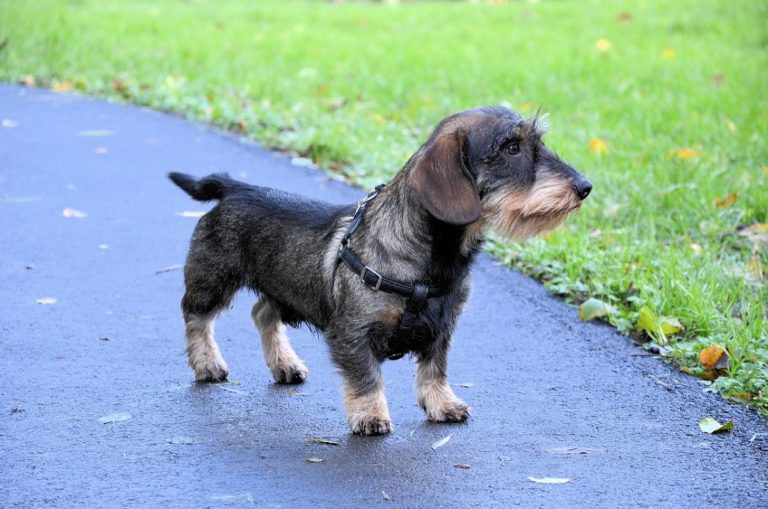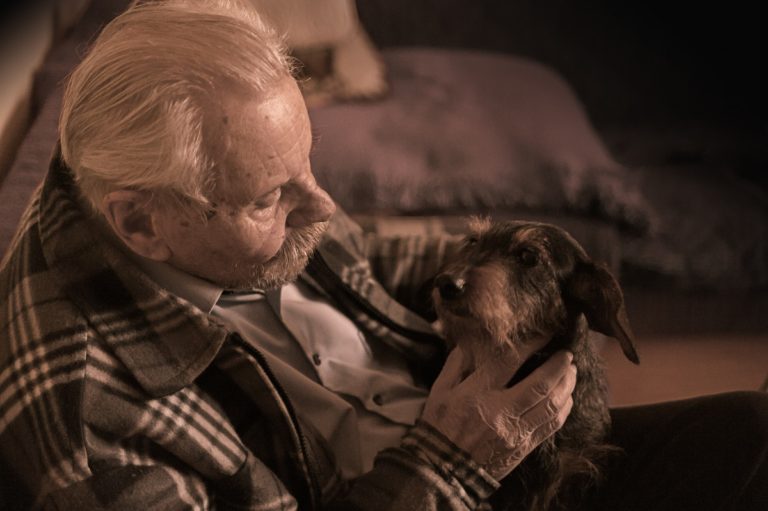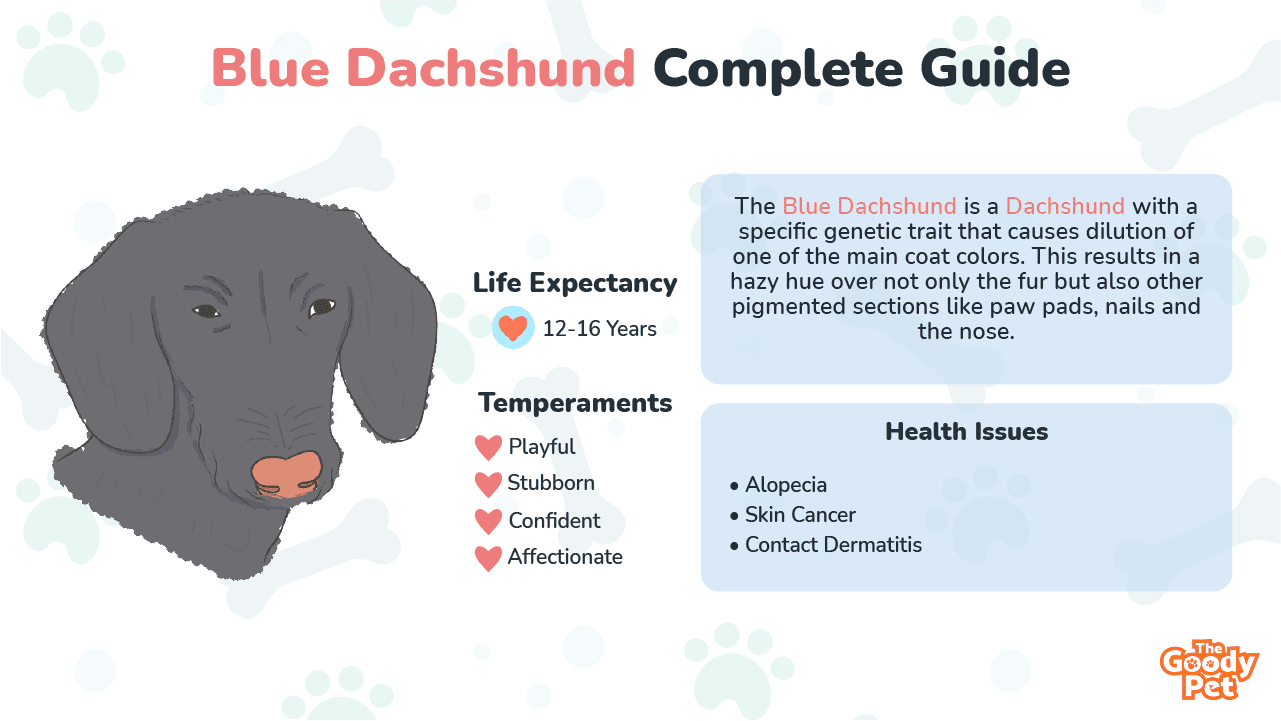I have always found it difficult to distinguish between many coat colors of the Dachshund. The little weenies are among my favorite so I am constantly looking for a new one to add to the family.
One of the most confusing color variants in my opinion is the Blue Doxie.
Contrary to popular beliefs, they are not blue in the way you would expect although a sky blue or weenie would probably be the cutest thing on the planet.
So what exactly is a Blue Dachshund?
Blue Dachshunds have a diluted shade of black which appears as a very hazy shade of bluish-grey. This is considered one of the most rare coat colors when it comes to Dachshund variants.
The color is a result of genetic mutation which affects the expression of black coat genes resulting in a more diluted hue. Other than the pigmentation, the Blue Dachshund is like any other Dachshund in terms of build and personality.
Despite being more or less like your regular common colored Doxie, the blue doggies have several specific care needs. In the sections below, you will learn all you need to about the dogs in terms of how to identify them and what to expect if you are interested in taking one home with you.
What Is A Blue Dachshund?

Dachshund dogs come in many different colors. The common ones include black, brown, and red and often occur as either solid colors or as combinations with tan sections.
There are rarer colors too which is where you will find the Blue Dachshund option. They are not the typical shades of blue but instead appear more like dark and metallic grey due to dilution of the black coat color.
The coat coloring of blue is a result of the presence of a recessive gene. To put it in simple terms, the gene dilutes the black spots on the Dachshund therefore creating the characteristic greyish color.
This colour dilution gene is known as the D locus. It is also the culprit of the Colour Dilution Alopecia (CDA), the more serious case of color dilution in animal coats.
The fact that it is recessive contributes to Blue Doxies being considered rare. This is because to produce one the parents must either both be Blue Dachshunds or carriers of the specific gene.
When it comes to coat appearance, they are just like any other Doxie. More often than not they have long and smooth or short and smooth fur types. These are single-layer coats and are associated with moderate shedding.
Occasionally, the blue weenie may have a wiry coat in which case it is usually a thicker and double-layer type.
Something interesting about the Blue Dachshund is that it is completely incapable of producing pure black pigmentation. This includes the nails, nose, whiskers, and paw pads. These locations also have more blueish-grey tones, which is a significant identifier.
Other than the coat and other regional pigmentation, the Blue Dachshund is just like any other Doxie. They have the same long torso, short legs, weigh between 16 to 30 lbs, and grow up to 15 inches in size.
How Are Blue Dachshunds Different From Fawn (Isabella) Dachshunds?

The Isabella Dachshund is yet another coat color found in Dachshunds.
As with the Blue Doxie, Isabella doggies feature a specific genetic trait that causes dilution of one of the main coat colors. This results in a hazy hue over not only the fur but also other pigmented sections like paw pads, nails and the nose.
The Isabella color is the result of the same D-locus gene, which is also recessive.
As a result, two Isabella Doxies or carriers of the gene have to mate in order to produce the dogs which also happen to be known as Fawn or Lilac Dachshunds. This is actually one of the reasons why they are so rare and are actually more often than not intentionally bred for the aesthetic because they very rarely occur naturally.
That is where the similarities end between the Dawn and the Blue Dachshunds. It is as a result of these similarities that the two are so often mistaken for one another. However, they are both very distinct with different appearances. Here are the two key differences.
Coat Color
The Isabella or Fawn Dachshund is a Doxie whose coat features a diluted brown color. A common misconception is that the dilution causes them to appear tan. Instead, what you get is a hazy and pale brown which is what the dog is known for.
Blue Dachshunds on the other hand feature diluted shades of black. The resulting color is a greyish hue.
Paws, Nose And Nails
The nose, paws and nails on an Isabella Doxie are brown in color. Those of a Blue Dachshund on the other hand tend to be a bluish-grey shade.
Do Blue Dachshund Have Skin Problems?
The Blue Dachshund coat color is associated with specific skin problems. This is because of dilution of the protective pigmentation as well as other effects on the skin, fur and coat in general. Let us take a look at some of the most common of these issues.
Alopecia
Alopecia on a Dachshund refers to the loss of fur. This may occur in localized patches or as a generalized loss of fur. It is different from regular shedding in that it occurs so frequently and in such high volumes that it may leave patches.
This issue is common with Blue Dachshunds because the trait is often associated with more brittle fur. If your Doxie suffers from this issue then get them Davis TheraCoat for Pets. This helps with growing the fur back with results as early as 1 month into using the product.
Skin Infections
Blue Dachshunds often have delicate skin. It is therefore more likely for them to develop skin infections. They are particularly prone to pest infestations including fleas and ticks.
Contact Dermatitis
This is a condition that is common with Doxies in general and the blue ones are unfortunately not spared. It occurs as an allergic reaction to things like fabrics, chemicals and pests.
Sunburns
Blue Dachshunds have thin hair and are therefore more exposed to UV rays. You could protect your pooch by getting them the Gold Paw Sun Shield Dog Tee for those fun days outdoors together.
Skin Cancer
This includes cancers like melanoma and mast cell tumors that may be sporadic or as a result of long term UV exposure.
Other Common Health Problems Of A Blue Dachshund
In addition to the skin conditions, Blue Dachshunds suffer from several other health problems. These are what you would expect with any other Doxie. Without further ado, here are the top 6 most common diseases you may have to deal with raising a Blue Doxie.
Intervertebral Disc Disease
This is a disease of the cartilage between vertebrae on your Dachshund’s back. It is associated with spinal cord injuries, which cause a lot of pain and may result in paralysis.
Obesity
Doxies are known for their ravenous appetite. This, coupled with skeletal issues that hinder mobility or hormonal diseases that affect metabolism, often leads to obesity.
Hypothyroidism
This is a form of hormonal imbalance where the thyroid gland in the Dachshund does not produce enough of the thyroid hormones. This results in several systemic issues, including thinning hair, slow metabolism, and cold intolerance.
Heart Disease
In most cases, this happens to Doxies as they grow older and is often associated with other health issues like diabetes or obesity. However, it could also occur in young puppies in which case it is usually congenital malformations of the heart.
Patellar Luxation
This is a skeletal issue that causes the knee bone to progressively get looser in turn affecting mobility for the dog.
Hip And Shoulder Dysplasia
This is a disease that is characterized by abnormally formed shoulder and hip joints on the Dachshund. It is associated with arthritis which causes a lot of discomfort for the pooch. You could give them the Zesty Paws Hip & Joint Mobility Bone Broth which, in addition to promoting healing, helps to relieve joint pains by promoting lubrication.
Temperament Of A Blue Dachshund
The Blue Dachshund is just like any other Doxie when it comes to temperament. Here are some of the most common personality traits that you will see with one of these beautiful little doggies and what it means for you as a potential owner.
Affectionate
Blue Doxies are huge suckers for love and affection and are not afraid to show it whether it is by cuddling or following you around the house. They also love receiving attention and affection so be sure to pet and cuddle yours on a regular basis.
Playful
These doggies love to be active which is to be expected given their hunting dog past. They will insist in turning any moment with you into playtime or an exploration adventure just to work off all their energy.
Confident
Blue Dachshunds are also very confident. They are not afraid to explore unfamiliar places or investigate new people and even new pets that they come across no matter how big or small they may be.
Loyal
These pooches are loyal almost to a fault. They are particularly known for forming strong bonds with specific members of the family to whom they become eternally devoted. This makes them fantastic companion dogs.

Clingy
While the dog’s loyalty may be cute at first it can quickly lead to clinginess. This is associated with separation anxiety and issues like constant barking and crying whenever they are left alone even for short periods of time.
Stubborn
You will also have to deal with a lot of stubbornness when raising a Blue Dachshund. Though they are considered to be of average intelligence, they have their moments where they simply do not want to do what they are told. This becomes especially problematic when it comes to training them.
Related Questions
How Much Does A Blue Dachshund Cost? A Blue Dachshund may not be very common but it costs the same as most other Dachshunds. Depending on the breeders, the average price range falls between $400 to $1,100. However, it can be as high as $1,500 for high pedigree Doxies. You can also get one for as low as $100 or even free if you go the rescue adoption route.
Are Blue Dachshunds Rare? Blue Dachshunds may not be the rarest of Doxies but they are relatively uncommon. This is mainly due to the recessive nature of the genetic trait responsible for their color. In fact, unless intentionally bred, it is quite rare to have them occurring naturally from two random Doxies of other colors.
What Is The Rarest Dachshund Color? The rarest Dachshund coat color is pure black. More often than not, black occurs in combination with tan markings. Blue and Fawn Doxies are also quite rare when it comes to color variations in the breed. On the other end of the spectrum, tan and red are the two most common Dachshund colors and may occur as single colors or in pairs with the other primary Doxie colors.





